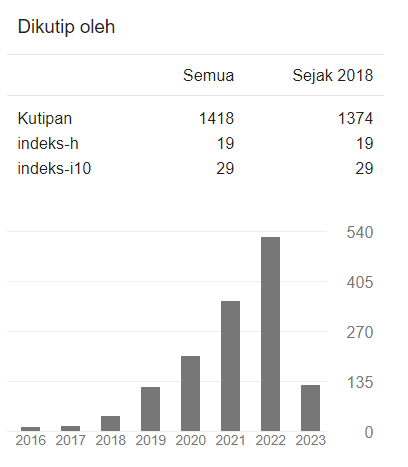How To Teach Deaf Students In Elementary Schools?
DOI:
https://doi.org/10.22219/jp2sd.v9i1.14969Keywords:
Teach, Deaf Student, Elementary School.Abstract
Deafness is a hearing loss that is different from other normal students so that a teacher must be able to provide optimal learning so that the purpose of this study provides an overview of the learning done by the teacher in teaching students. The use of this research method is a qualitative method using observation and interview instruments. Technical analysis of data 1) Reducing data means making a summary, choosing the main things, focusing on important things, looking for themes and patterns, discarding what is considered unnecessary. 2) Presentation of data is directed so that the results of the reduction data are organized, arranged in a relationship pattern so that it is more easily understood 3) The initial conclusions put forward by researchers are still temporary and will change if strong evidence is found that supports the next stage of data collection. The results of this study illustrate that learning for students with disabilities should pay more attention by giving views and touches so that they know that the teacher invites them to communicate that has a facial expression. Not too many methods are used in teaching but the approach is done by solving problems and providing concrete examples by maximizing voices and facial expressions in a voice in order to train the hearing of deaf students.
Downloads
References
Adeleke., & Gideon, A. (2018). Teachers’ Familiarity and Opinion on Utilization of Narrative Recollection Technique in Basic Schools in Nigeria. International Journal Of Innovative Research & Development, 7(12), 37- 42. DOI: 10.24940/ijird/2018/v7/i12/OCT18028.
Alsamiri, Y. (2018). HOW LEARNING DISABILITIES TEACHERS IN THE KINGDOM OF SAUDI ARABIA DEFINE STUDENTS WITH GIFTEDNESS AND LEARNING DISABILITIES. Cakrawala Pendidikan, XXXVII (3). 356- 365.
Baker, E. T., Wang, M. C. & Walberg, H. J. (1994) The effects of inclusion on learning. Educational Leadership, 52(4), 33–35.
Berninger, V. W., & Abbott, R. D. (2013). Differences between children with dyslexia who are and are not gifted in verbal reasoning. Gifted Child Quarterly, 57(4), 223–233. doi: 10.1177/0016986213500342.
Chowdhury, M., & Benson, B.A. (2011). Deinstitutionalization and Quality of Life of Individuals With Intellectual Disability: A Review of the International Literature. Journal of Policy and Practice in Intellectual Disabilities, 8(4), pp 256–265.
Carney, T. (2013). Participation and service access rights for people with intellectual disability: A role for law?. Journal of Intellectual and Developmental Disability, 38(1), 59-69. Doi: http://dx.doi.org/10.3109/13668250.2012.738810.
Dewi, Y.E., & Kurniaman, O. (2019). Analisis Keterampilan Dasar Menjelaskan oleh Guru Dalam Mengajarkan Membaca Permulaan Siswa Tunagrahita di SDLB Kasih Ibu Pekanbaru. Primary: Jurnal Pendidikan Guru Sekolah Dasar, 8 (1), 37-46. DOI: http://dx.doi.org/10.33578/jpfkip.v8i1.6361.
Efendi, M. (2008). Pengantar Psikopedagogik Anak Berkelainan. Jakarta: PT Bumi Aksara.
Frielink, N., & Embregts, P. (2013). Modification of motivational interviewing for use with people with mild intellectual disability and challenging behavior. Journal of Intellectual and Developmental Disability, 38(4), 279-291. DOI: 10.3109/13668250.2013.809707.
Fauziah, A., & Guslinda. (2019). Analisis Keterampilan Guru dalam Mengelola Kelas Siswa Tunarungu di SDLB Kasih Ibu Pekanbaru. Primary : Jurnal Pendidikan Guru Sekolah Dasar, 8 (1), 28-36. DOI: http://dx.doi.org/10.33578/jpfkip.v8i1.6360.
Hallahan, D. P. & Kauffman, J. M. (1991). Exceptionality Childern Introduction to Special Education (fifth ed.). New Jersey: Prentice Hall International, Inc.
Haenudin. (2013). Pendidikan Anak Berkebutuhan Khusus Tunarungu. Jakarta Luxima.
Hu, X., Wang, M., & Fei, X. (2012). Family quality of life of Chinese families of children with intellectual disabilities. Journal of Intellectual Disability Research, 56(1), 30- 44. doi: 10.1111/j.1365-2788.2011.01391.x.
Jasmini. (2019). Pembelajaran Metode Demontrasi dan Alat Peraga Terhadap Hasil Belajar PKn Siswa Kelas III SDN 004 Teratak Buluh Kecamatan Siak Hulu. Jurnal PAJAR (Pendidikan dan Pengajaran), 3(4), 711- 722. DOI: http://dx.doi.org/10.33578/pjr.v3i4.7225.
Kurniaman, O., & SB. Sismulyasih, N. (2019). The Influence of The Big Book Media Has The Character of Conservation in Early Reading. ELS Journal on Interdisciplinary Studies in Humanities, 2(1), 141-147.
Kurniaman, O., & Noviana, E. (2016). Metode Membaca SAS (Struktural Analitik Sintetik) dalam Meningkatkan Keterampilan Membaca Permulaan Di Kelas I SDN 79 Pekanbaru. Primary: Jurnal Pendidikan Guru Sekolah Dasar, 5(2), 149- 157.
Katrin, S. (2019). Pengaruh Pola Kepemimpinan Kepala Sekolah terhadap Kinerja Guru Di SD Negeri 6 Mandau. Jurnal PAJAR (Pendidikan dan Pengajaran), 3(5), 1102-1112. DOI: http://dx.doi.org/10.33578/pjr.v3i5.7845.
Kurniaman, O., Noviana, E., Charlina., Simulyasih, N., Handayani, N. D., Sofyan, N. S., Zufriady., & Septyanti, E. (2018). Why Should Primary Teachers Develop Learning Material by Directed Reading Thinking Activity (DRTA) Strategy?: 4-D Model. Advanced Science Letters, 24 (11),8389–8391. DOI: https://doi.org/10.1166/asl.2018.12570.
Kriyantono, R. (2006). Teknik Praktis Riset Komunikasi. Jakarta: Prenada.
Myklebust, J. O. (2007). Diverging paths in upper secondary education: competence attainment among students with special educational needs. International Journal of Inclusive Education, 11(2), 215-231. DOI: 10.1080/13603110500375432.
Makovec, D. (2018). The Teacher’s Role And Professional Development. (IJCRSEE) International Journal of Cognitive Research in Science, Engineering and Education, 6(2), 33-46. doi:10.5937/ijcrsee1802033M.
Wormald, C. (2011). Teachers’ knowledge of gifted learning disabled children in NSW. In C. Wormald, & W. Vialle (Eds.), Dual Exceptionality (pp. 87 94). Wollongong: Australian Association for the Education of the Gifted and Talented.
Wormald, C., Vialle, W., & Rogers, K. (2014). Young and misunderstood in the education system: A case study of giftedness and specific learning disabilities. Australasian Journal of Gifted Education, 23(2), 16– 28.
Downloads
Published
Issue
Section
License
Copyright (c) 2021 Jurnal Pemikiran dan Pengembangan Sekolah Dasar (JP2SD)

This work is licensed under a Creative Commons Attribution-ShareAlike 4.0 International License.
Authors who publish with Jurnal Pemikiran dan Pengembangan Sekolah Dasar (JP2SD) agree to the following terms:
- For all articles published in Jurnal Pemikiran dan Pengembangan Sekolah Dasar (JP2SD), copyright is retained by the authors. Authors give permission to the publisher to announce the work with conditions. When the manuscript is accepted for publication, the authors agree to automatic transfer of the publishing right to the publisher.
- Authors retain copyright and grant the journal right of first publication with the work simultaneously licensed under a Creative Commons Attribution-ShareAlike 4.0 International License that allows others to share the work with an acknowledgment of the work's authorship and initial publication in this journal.
- Authors are able to enter into separate, additional contractual arrangements for the non-exclusive distribution of the journal's published version of the work (e.g., post it to an institutional repository or publish it in a book), with an acknowledgment of its initial publication in this journal.
- Authors are permitted and encouraged to post their work online (e.g., in institutional repositories or on their website) prior to and during the submission process, as it can lead to productive exchanges, as well as earlier and greater citation of published work (See The Effect of Open Access).

This work is licensed under a Creative Commons Attribution-ShareAlike 4.0 International License.


















